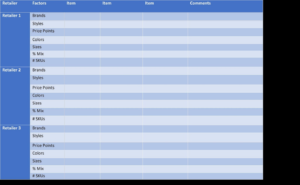By Rosario Buitrago, Business Analyst Intern at Enhanced Retail Solutions
Introduction
Running a successful business requires a deep understanding of the competitive landscape. By closely examining the strategies used by your competitors, you can identify your own strengths, weaknesses, and opportunities. A simple act such as walking the sales floor can provide invaluable insights into your market and the competitive landscape. If you know what to look for!
What is Competitive Shopping?
Competitive shopping involves analyzing actions and strategies of your competitors based on specific observable characteristics called attributes. These attributes act as clues that help determine the criteria necessary for your business’s success. They also provide a way to examine the POS performance of your business. Examples of such attributes include brand, style, color, size, and location within the store. By examining these attributes, you can gain insights into criteria such as pricing strategy, organizational tactics, and overall investment. An excellent place to practice competitive shopping is within one of America’s favorite department stores: Macy’s.
Decoding Pricing Strategies
To gain a comprehensive understanding of a competitor’s pricing strategy, it is crucial to pay attention to specific details. Carefully examine the pricing of individual items and take note of any discounts offered. Once you have collected a range of prices, organize them in a manner that best suits your analysis. You might discover that a particular brand uses different pricing strategies for bottoms and tops, or based on size. By categorizing prices into tiers, you can shed light on a competitor’s overall pricing strategy.
Analyzing Organizational Tactics
The way a brand arranges its merchandise on the sales floor plays a significant role in influencing consumer behavior. Taking Calvin Klein as an example, close observation might reveal that tops and bottoms that are part of sets are intentionally placed together and positioned prominently for maximum visibility. In contrast, dresses and jackets are positioned on the wall rather than on a rack, possibly indicating a deliberate effort to highlight these items. These intentional placements provide valuable insights into which products a brand prioritizes and promotes more avidly.
Evaluating Total Investment
Competitive shopping can also help gauge the investment a brand has made in establishing its presence. Examining the organizational tactics discussed earlier, a data point that offers insights into investment is the inventory present on the sales floor and the space it occupies. By taking note of the quantity of each item and the number of tiles it occupies, valuable inferences can be drawn about your competitor’s inventory planning. For instance, if there are 24 high-waisted pants and 12 low-cut tops, it can be inferred that the investment in low cut tops is approximately 50% that of the investment in high waisted pants. Moreover, if tops take up approximately 3 tiles out of 30, and bottoms take up 6 tiles, this analysis reveals that low-cut tops account for around 10% of the total brand’s investment, while high-waisted pants make up approximately 20%.
This same analysis can also be applied to the overall investment that a brand has made in a store as a whole. For instance, counting the number of tiles occupied by Calvin Klein can provide a more precise assessment of how much they invested into their store presence compared to other brands. If Calvin Klein occupies 60 tiles, and Express takes up 30 tiles, then it can be inferred that Calvin Klein invested double that of Express in store space.
Basic Competitive Shopping Template
A great place to start when competitive shopping is by using an organized chart, such as the one below:

Competitive Shopping Chart with Attributes
Learn more about retail planning with our free resources. They can be found at our resources page.
Conclusion
Competitive shopping provides businesses with a powerful tool to gain in-depth knowledge about their competitors and the market landscape. By carefully observing and analyzing the actions and attributes of competitors, businesses can make informed decisions and develop effective strategies.
However, it’s important to note that competitive shopping is not foolproof and doesn’t provide exact, definitive answers. Rather, it offers valuable clues and allows businesses to make informed inferences about their competitors’ strategies and market dynamics. It serves as a starting point for deeper analysis and should be supplemented with other market research methods and data sources.


Comments are closed